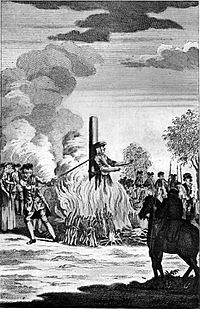Burning of women in England facts for kids
In England, burning was a legal punishment inflicted on women found guilty of high treason, petty treason, and heresy. Over a period of several centuries, female convicts were publicly burnt at the stake, sometimes alive, for a range of activities including coining and mariticide.
In the latter half of the eighteenth century, changing attitudes to such public displays prompted Sir Benjamin Hammett MP to denounce the practice in Parliament. His bill, by no means the first such attempt to end the public burning of women, led to the Treason Act 1790, which abolished the sentence.
Images for kids
-
Woodcut of the burning of Anne Askew, for heresy, at Smithfield in 1546

All content from Kiddle encyclopedia articles (including the article images and facts) can be freely used under Attribution-ShareAlike license, unless stated otherwise. Cite this article:
Burning of women in England Facts for Kids. Kiddle Encyclopedia.




